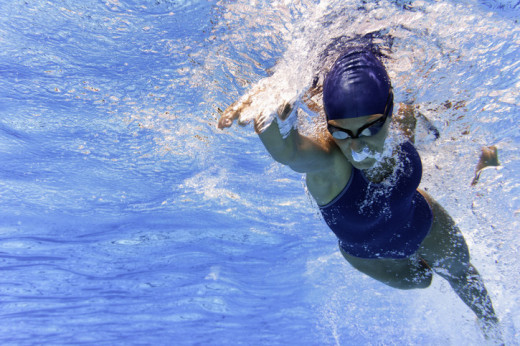- Patient Resources
- Scheduling An Appointment
- Pre-Registering Prior To Your Appointment
- Patient Portal
- Appointment Policies
- Insurance
- Referrals, Workers' Comp & Litigation
- Financial Information
- Preparing For Your Office Visit
- Preparing For Your Surgery or Procedure
- Share Your Medical Images With Andrews Sports Medicine
- Travel & Area Information
- Online Bill Pay
- Financing
- Medical Records
- Prescriptions
- Durable Medical Equipment (DME)
- Injury Prevention
- Purchase Andrews Sports Medicine Gear

Swimming Injuries
Swimming is among the most popular low-impact fitness activities, with more than a million competitive and recreational swimmers in the United States. More than one-third of these athletes practice and compete year-round. Elite swimmers may train more than five miles a day, putting joints through extreme repetitive motion. Most swimming injuries affect the shoulders, knees, hips, or back, depending on stroke.
What Causes Swimming Injuries?
With overuse comes fatigue and failure to adhere to proper stroke techniques. Often swimmers demonstrate tremendous flexibility or joint laxity, which can be normal. Slight injuries and micro-trauma can cause shoulders to become unstable and lead to shoulder pain and tendinitis. Other repetitive injuries include inner knee problems and hip problems from breaststroke kicking, and back injuries from dolphin kicks or dry-land cross-training.
What Are The Most Common Swimming Injuries?
Swimmer’s Shoulder
The shoulder is the joint most commonly affected by swimming injuries or overuse. Shoulder injuries may include rotator cuff impingement — pressure on the rotator cuff from part of the shoulder blade or scapula as the arm is lifted. Biceps tendinitis (painful inflammation of the bicep tendon) and shoulder instability, in which structures that surround the shoulder joint do not work to maintain the ball within its socket, all can result from fatigue and weakness of the rotator cuff and muscles surrounding the shoulder blade.
Lower Body Injuries
Knee injuries that involve the tendons and ligaments (breaststrokers’ knee) are common. Breaststrokers may also experience hip pain from inflammation of the hip tendons.
Back problems, including lower back disk problems or another problem at the junction between the spine and pelvis, termed spondylolisis, may be increased by the dolphin kick often used in competitive swimming.
How Can Swimming Injuries Be Prevented and Treated?
- Communication among athlete, parent, coach, and medical professional is critical to both injury prevention and successful recovery
- Use good stroke technique
- Lessen repetitive strokes that are causing the overuse injury
- Perform core strengthening and cross-training exercises as part of pre and early season routines
- Consider alternative training techniques rather than training through an injury
- Use periods of rest to recover
- Focus rehabilitation efforts on rotator cuff and scapular strengthening for most shoulder injuries and pelvic and hip strengthening exercises for hip and knee injuries
- Speak with a sports medicine professional or athletic trainer if you have any concerns about injuries or prevention strategies
- The athlete should return to play only when clearance is granted by a health care professional







